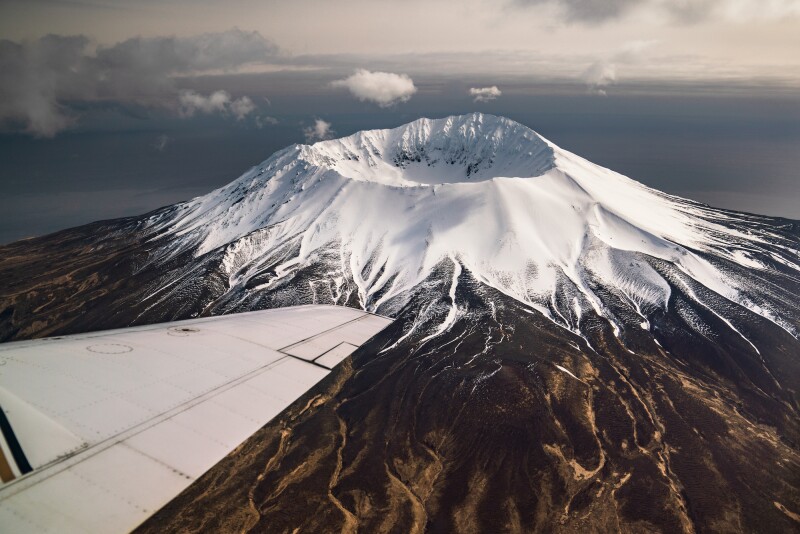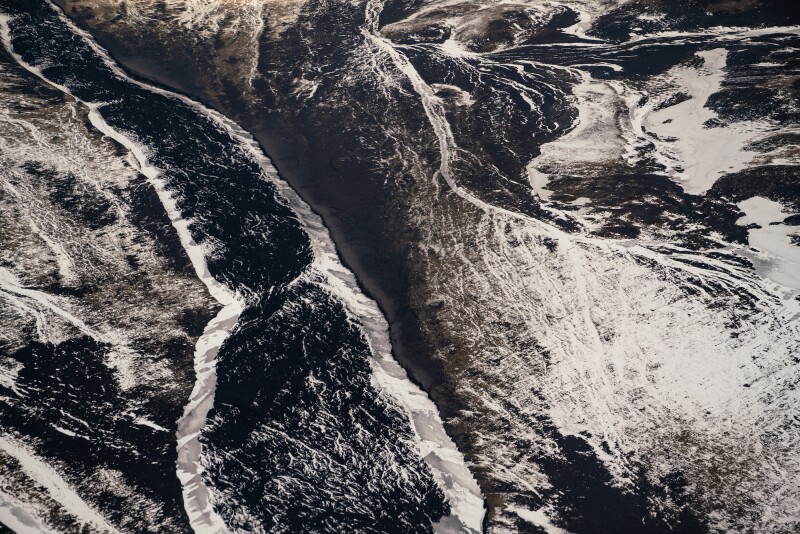Chris Burkard is one of the world’s most well-known adventure photographers.
Over the course of his career, Burkard has won multiple prestigious photography awards; amassed more than three million Instagram followers; compiled a lengthy catalog of films, books, and magazine covers; worked with clients like The North Face, Patagonia, and Red Bull; and delivered a TED Talk that’s currently encroaching two million views.
Earlier this year, as part of a grant he received from nonprofit environmental organization Conservation International, Burkard traveled to the Aleutian Islands—a secluded volcanic archipelago that spans the waters between Alaska and Russia—to document the rarely visited island chain for conservation-oriented research.
With a commitment to environmentalism as the through line of his work, Burkard could be considered something of an Ansel Adams for the Internet age. We spoke to the professional photographer about the tricks that help him capture some of the world’s most beautiful natural landscapes, including the Aleutian Islands.

The Aleutian Islands stretch from the tip of the Alaska Peninsula toward Russia’s Kamchatka Peninsula.
Photo by © Chris Burkard / Courtesy of Conservation International
Practice and pursue
Burkard’s first foray into photography began as a teenager when he spent his free time photographing surfers in his hometown on California’s central coast. He wasn’t yet working professionally, but he was beginning to build his portfolio with each image he shot. “I gave myself assignments to create the type of work I wanted to be assigned in the future,” Burkard says. “Those projects weren’t making me any money, but the process was slowly teaching me a lot.”
His perseverance paid off: In 2006, Burkard began interning at surf magazines and was awarded a hefty grant from Follow the Light Foundation, an organization that helps financially support burgeoning surf photographers. Burkard used the grant money to fund a surf-focused road trip along the Pacific coast from Oregon to Mexico, which resulted in a photo book called The California Surf Project. Within a few years, Burkard had established himself as a full-fledged outdoor and adventure photographer. This feat, Burkard says, was largely the result of his commitment to the craft during the years in which he wasn’t getting paid to pursue it.
“The projects I’m able to work on now—those weren’t things anybody initially came to me and asked me to do,” Burkard says. “A big component of how I’ve been able to do what I now do is the result of investing personal time and being willing to make lots of mistakes.”
For Burkard, the first step toward bettering your skills as an outdoor photographer comes in the form of consistently pursuing passion projects. Not only will you familiarize yourself with the process of photo-taking, but you’ll also refine your personal style.

Native Aleut communities have occupied the islands for some 8,000 years. “Today, Dutch Harbor is one of the few islands in the Aleutian chain with yearly inhabitants,” Burkard explains.
Photo by © Chris Burkard / Courtesy of Conservation International
Do your research
Many beginner-level photographers are taught to prioritize understanding terms such as depth of field, shutter speed, and white balance. While learning how to use a DSLR can be an important step in the right direction, Burkard believes there are significant ways to improve the images you capture that have very little to do with the technical aspects of working a camera.
“As photographers, we have so much information at our fingertips—you can Google 99.9 percent of what you need to know to work a camera,” Burkard says. “To me, it’s important to always take the time to read up on the place you’re planning to photograph,” he says. “The research you do before your trip will give you a sense of what you’re looking at—and what you should be looking for.”
“I ask myself, ‘What’s the story I want to tell?’”
For Burkard, the most useful information to seek out isn’t just about the various terrains to shoot, but also the people who might be most familiar with them. “I love seeing beautiful landscapes like the remote corners of Iceland and Greenland,” he says. “But seeing those places through the eyes of my ship’s captain—that’s where the story is.”
Burkard recommends connecting with local experts before or during your trip. Tour operators, adventure guides, and even fellow outdoor enthusiasts can often point you toward the elements of a place that truly reflect what makes it special. “If you can hone in on those things,” Burkard says, “you’re going to know the perspectives that will make your images beautiful.”

Situated between the Pacific Ocean and the Bering Sea, the Aleutian Islands occupy a total area of 6,821 square miles.
Photo by © Chris Burkard / Courtesy of Conservation International
Seek out details
“Storytelling is a matter of learning to listen, observe, and digest,” Burkard says. “I’m not the most technically savvy photographer at all, but I have tried to understand how to form a narrative. That’s the approach I take to utilizing social media, film, and photography. I ask myself: What’s the story I want to tell?”
Burkard’s primary purpose for visiting the Aleutian Islands was scientific: He received a grant from Conservation International to create a photographic survey of the volcanic island chain for environmental research efforts and preservation projects. But the professional photographer’s massive social media following allows him to bring stories from some of the world’s most remote corners to audiences across the globe. So that’s what he did.

In the Aleutians, high winds, heavy rainfall, and dense fog are near constant. “Even during our visit in March, signs of winter still lingered,” Burkard says.
Photo by © Chris Burkard / Courtesy of Conservation International
“We have these natural landscapes that are protected, and often times they’re so remote that we truly never have the opportunity to understand why they’re important to preserve,” Burkard says. “One of my privileges is being able to take part in providing images that answer some of those questions.” In the Aleutian Islands, he focused on finding details that he felt illuminated the scope and scale of some of the world’s most active volcanoes. “The goal is to search for anecdotes that give a sense of where you are,” Burkard says. “Look for unique aspects of the place that you’re in and hone in on those details.”
Use what you know
In addition to his professional projects, Burkard also leads intensive photography workshops—both online and on-site—where he provides technical training, social media advice, and overall insights on his photographic philosophy.
What does Burkard tell these aspiring outdoor photographers?

The archipelago consists of 14 large islands, approximately 55 small islands, and innumerable islets, most of which bear marks of volcanic origin—and some of which are still active.
Photo by © Chris Burkard / Courtesy of Conservation International
“The best camera you can have with you is the one you’re willing to pull out,” Burkard says. While there are benefits knowing how and when to use more advanced camera gear like polarizing filters and wide-angle lenses, Burkard believes photographers at every level should use the tools they’re most comfortable with—whether that be an iPhone or a DSLR. “At a certain point, it’s not about about technical skills, but about stopping to ask yourself: What am I going to give back to this place that’s given me so much?,” Burkard says. “If we fail to focus on sharing with others a sense of what it was like to be in the places we photograph, we lose the opportunity to truly inspire them.”
Follow Burkard’s adventures on Instagram.
>>Next: Take a Rare Look Inside One of the World’s Most Remote Regions











